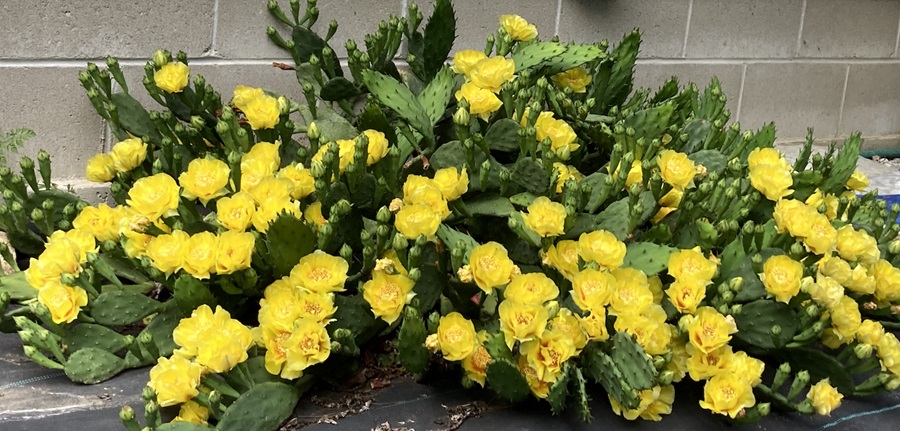Out in the Woods
- October 4th 2024
- Out in the Woods

Photo: Kevin McKeon
By Kevin McKeon, Maine Master Naturalist
Prickly Pear creeping into Maine
Cacti in Maine!? Yup! Sort of. A cactus is making its way here from New Hampshire and is listed as native to all New England states except Vermont and Maine. It’s called the Eastern Prickly Pear Cactus (Opuntia humifusa) because of the pearlike shape of its fruit and it’s unrelated to the pear. Another one of its names, the Indian Fig, relates to the fruit’s size. It’s also called The Devil’s Tongue, reflecting the makeup of its “leaves”. These beauties can be found in some gardener’s backyards that offer well-drained, sandy soils and lots of sun. Its natural habitat is along the coastal plains: dry fields, ledges, coastal dunes and beaches. This succulent is easy to identify as it looks like a cactus. Cuttings can be easily transplanted to your backyard in very dry, sunny locations, meadows, dry hilltops, recently harvested forests — maybe even in your outgrown kid’s sandbox.
Speaking of names: There’s another cactus species, Opuntia cespitosa, very similar to our O. humifusa, and is also commonly called the eastern prickly pear cactus. But the flower of O. cespitosa, unlike the O. humifusa, has a red center. All these names serve to highlight the reasons many gardeners often use botanical names when discussing their plantings. Plant names can be different for the same plant, and different plants may have the same local names: O. humifusa is commonly called the Eastern Pear Cactus, Eastern Prickly Pear Cactus, Prickly Pear Cactus, Indian Fig, or The Devil’s Tongue. World-wide, in all languages, it’s called Opuntia humifusa.
Under an optimal, desert-like habitat, the prickly pear can grow to 6 feet tall with 16 inch long “leaves” which are called pads or nopals and are modified sections of the stem. Around here, 1.5 feet is about the tallest it’ll get. The spines grow from small light- to dark-colored bumps located on the cactuses cladodes, which are found on the nopals. The spines have barbs on the ends, so can be uncomfortable to touch and pull-out from probing fingers. These plants are loaded with all kinds of chemicals — which has generated research into many medical applications — so it’s no surprise that some folks have reported reactions (other than an “ouch”!) to these spinal encounters.
And they are edible. Prickly pear cactus has been a staple in Mexican and Central American diets for thousands of years. It is described as sweet, similar in flavor to a melon. There are two edible parts of this cactus: The spine-covered nopal which is often treated as a vegetable and the pear-shaped fruit. Prickly pears are loaded with flavonoids and vitamin C, giving the plant excellent antioxidant properties. They also contain calcium, minerals, amino acids, etc., and have been used to treat cancer, fungal issues, hypertension, diabetes, and heart diseases. Be careful when you pick and peel them and wear protective gloves. Read and watch about food prep here.
Prickly pear’s bright yellow flowers attract many types of pollinators: ants, wasps, birds, and bees. Native bees will sometimes overnight in the closed blossoms and emerge as the sun’s morning rays cause the blossom to open. After pollination, the red, fig-shaped fruits are formed and can be eaten raw after carefully removing the skin; jellies, candies and other sweets can also be processed from them. The fleshy part of the prickly pear is made up of flattened-like stems called cladodes, covered in spines. These can also be eaten after bypassing the spines and skin.
It is not only a beautiful plant but also provides food and protection for wildlife and can be used in native landscaping. It could be a wonderful backyard addition to your pollinator gardens.
https://www.thespruceeats.com/prickly-pear-cactus-fruit-2343047






